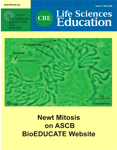In the Company of Geneticists
INTRODUCTION
This is a book about the history of genetics, mostly focusing on classical aspects. This historical work provides a more detailed look into the history of genetics that will benefit anyone studying or teaching the subject, particularly undergraduate instructors who could then provide various angles about pivotal discoveries. James Schwartz, an independent scholar, begins his detailed and well-researched book dealing with Charles Darwin and Francis Galton—slowly treading into pivotal discoveries that took place mostly in Europe. The second part of the book takes the reader to the United States and concentrates on the work done on chromosomes using the fruit fly in Thomas Hunt Morgan's lab and the significant applications that emerged from such work. Only the Epilogue deals with advances in molecular genetics.
FROM PANGENESIS TO CHROMOSOMES
The book begins with a discussion of pangenesis as a response of Darwin to inheritance as a mechanism to explain variation among organisms. Chapters 2 and 3 focus on Galton and the eugenics movement, followed by the work of some of his “disciples.” In Chapter 3, the reader gets to know William Bateson and his ideas on evolution. Additional players are covered in sufficient detail. Schwartz is very meticulous in his descriptions of the scientists as they enter the picture. Careful research and a substantial use of primary sources make the account extremely detailed. Accounts of experimental work are covered with incredible precision.
Chapter 4 allows the reader to understand how Hugo de Vries came to rediscover Gregor Mendel's work 35 yr after it was published. The book's narrative picks up significant pace in Chapter 5, dealing with Mendel. The life of Mendel as a monk, researcher, and as a man are well-detailed. The precision of his experiments with Pisum is explained in great length, and Schwartz even describes his further experiments on hawkweed, which did not match his previous work in terms of the elegant data acquired. The rediscovery of Mendel's work that is greatly oversimplified in most textbooks is carefully laid out in terms of some of the skepticism that prevailed. The early twentieth century saw a war against Mendelism, with some figures arguing that Mendelian analysis was ambiguous (p. 121). Four papers were published establishing anti-Mendelian arguments, and the issues raised were wrong.
In 1902, it was asserted by the influential Bateson that “Mendelism ranked among the most important discoveries in the history of theoretical biology” (p. 116). At the same time, the rise of cell biology was taking place. Understanding of the fusion of egg and sperm was recognized as a revolutionary advance, followed by August Weismann's role in deciphering meiosis. An entire chapter is devoted to sex chromosomes and Morgan's discovery of crossing over, which ended up refining Mendel's ideas. The work of Morgan's students in the “Fly Room” is the subject of another chapter.
From then on the author focuses on Hermann Joseph Muller, who went on to win the Nobel Prize for his work on inducing mutation with X-rays. Then Schwartz goes on to describe Muller's work and persona. The reader should become convinced about the significance of Muller's contribution to modern genetics. At this point, the figure of Morgan is somewhat tainted, as he is portrayed as someone who gained glory at the expense of his students' work without giving them proper credit. The personal life of Muller is described in much detail, and the reader may sympathize with him while getting tired of so much coverage in this book. In addition, one can sense some bias by having some of the accomplishments of other “fly boys” overlooked and not properly mentioned.
MOLECULAR GENETICS IN A NUTSHELL
The series of accomplishments in molecular genetics is discussed in the 13-page Epilogue. In a nutshell, the story starts with the discovery of Avery, MacLeod, and McCarty in 1944. Muller is showcased again when he concluded in 1945 “that Avery's transformations of pneumococci were due to the incorporation of the injected genes into the genome of the receiving bacteria by a process of crossing over entirely analogous to ordinary crossing over” (p. 278). The story behind the discovery of the double helix is described briefly. A reader looking for more details on the contributions of James Watson, Francis Crick, Maurice Wilkins, Rosalind Franklin, Linus Pauling, and Jerry Donohue would need to look at other books dedicated to the work that went on during the 1950s. There is some mention of discoveries in DNA technology and the milestone of the Human Genome Project. Once again, the figure of Muller is brought back in the last three pages of the Epilogue, and his visionary nature is described. Muller associated the mapping of genes and their association with complex human traits.
CONCLUSIONS
In Pursuit of the Gene is an important scholarly contribution to the history of classical genetics. It may not a reach the wide audience that it deserves because experiments are described in detail and the lay person may have a hard time following some of the chapters in the middle of the book. Nonetheless, anyone in biology who is not completely familiar with the history of classical genetics and the work that preceded it should gain much insight from this book. Educators and graduate students in life sciences should benefit a great deal by reading the historical accounts of major discoveries. Any teacher who wants to accurately portray some of the work that has laid out our current understanding of genetics and molecular biology should take a look at this book. Schwartz deftly portrays the collaborative—and sometimes brutally competitive—nature of scientific inquiry.



